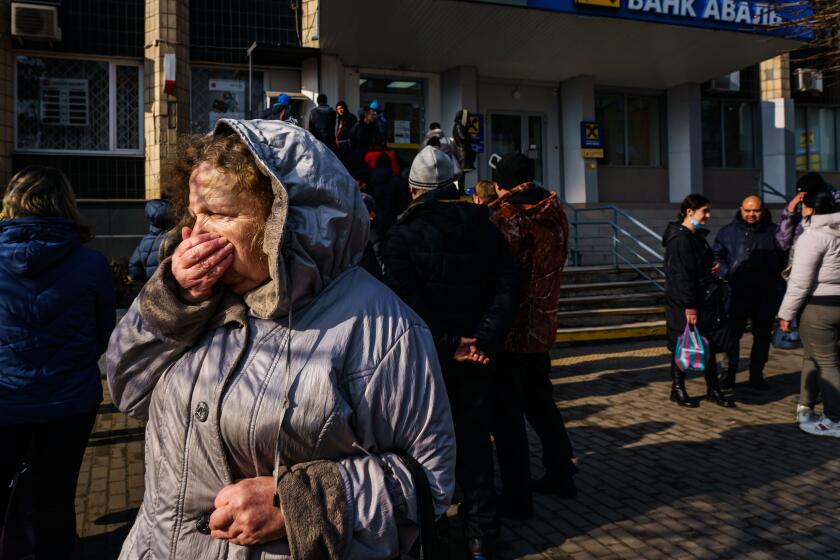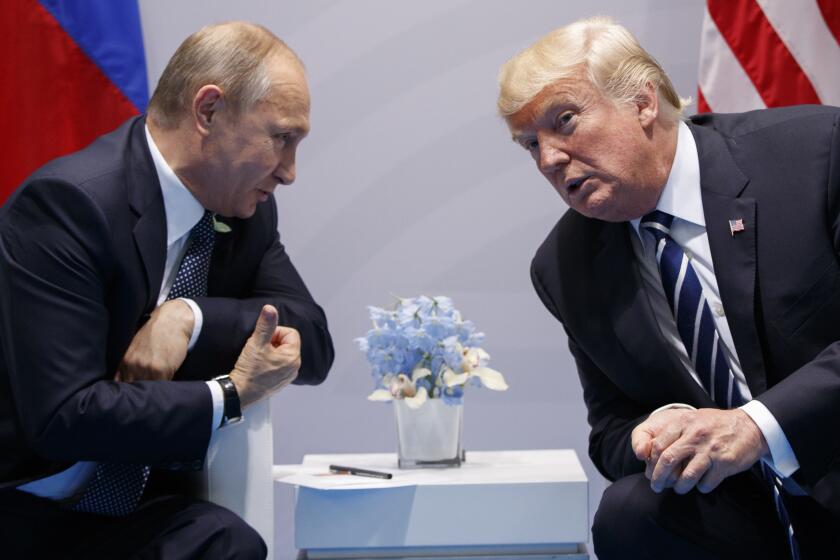Trump makes numerous false claims about Russia’s war on Ukraine. What are the facts?

- Share via
KYIV, Ukraine — President Trump this week falsely blamed Ukraine for starting the war that has cost tens of thousands of Ukrainian lives, causing outrage and alarm in a country that has spent nearly three years fighting back the invasion by Russia’s much larger military.
Trump called Ukrainian President Volodymyr Zelensky “ a dictator without elections” and claimed his support among voters was near rock-bottom.
Zelensky said Trump lives in a “disinformation space” created by Russia. Some of what Trump has said does echo Moscow’s narrative of its war on Ukraine.
Here’s a look at some of Trump’s statements:
False claims on who started the war
WHAT TRUMP SAID: “You’ve been there for three years. You should have ended it.... You should have never started it. You could have made a deal.”
THE FACTS: Russia’s army crossed the border on Feb. 24, 2022, in an all-out invasion that President Vladimir Putin sought to justify with false claims that it was needed to protect Russian-speaking civilians in eastern Ukraine and prevent the country from joining NATO.
Russia pressed ahead with its assault on neighboring Ukraine on Thursday, with explosions resounding in cities across the country, airstrikes crippling its defenses and reports of troops crossing the border by land and sea.Map: Tracking the invasion of Ukraine | How to help: California organizations supporting Ukraine | What our foreign correspondents are seeing in Ukraine | Photos: Invasion of Ukraine begins
But Russia’s aggression against Ukraine didn’t start then. In 2014, Putin saw signs that Ukraine was pulling away from Russia’s sphere of influence, seeking alliances with Western European nations. Putin illegally annexed the Crimean peninsula and started an armed aggression in the eastern Ukrainian region of Donbas that grew into a long-running conflict that left thousands dead.
That conflict simmered until 2022, when Putin ordered what he called military exercises along Ukraine’s borders. He told the world that the roughly 150,000 soldiers that he had massed would not be used to invade Ukraine. But in the early hours of Feb. 24, Russia launched widespread airstrikes and soldiers began pouring over the border.
President-elect Donald Trump and Russian President Vladimir Putin share some traits and want some of the same things. But a chasm divides them.
Ukraine’s elections
WHAT TRUMP SAID: “We have a situation where we haven’t had elections in Ukraine, where we have martial law.” The president spoke from Florida, adding on Wednesday in a post on social media: “A Dictator without Elections, Zelenskyy better move fast or he is not going to have a Country left.”
THE FACTS: Zelensky was elected to a five-year term in 2019, and the next presidential election had been scheduled for spring 2024. But Ukrainian law prohibits parliamentary or presidential elections during a state of martial law, so Zelensky has remained in office. He has said he believes elections will be held in Ukraine after martial law is lifted. The country would need to amend the law if it decided to hold a vote.
There are numerous factors that, according to Ukraine’s government, “would render it literally impossible to ensure a fair electoral process in the circumstances of a total war.”
According to the United Nations’ refugee agency, about 6.9 million Ukrainian refugees have been registered worldwide since February 2022. Of those, millions remain outside the country because of the war. It would be nearly impossible for all of those who have been displaced to participate in an election, potentially robbing millions of their right to vote.
Furthermore, about 800,000 soldiers are serving in the Ukrainian armed forces as they struggle to contain Russian advances. An election would necessitate pulling soldiers off the front lines to vote, weakening Ukraine’s military position. Additionally, those fighting would be unable to run for office, a right that is guaranteed to them by Ukrainian law.
Many Ukrainians are living in areas under Russian occupation, essentially precluding their participation in any electoral process. And given that Russia continues to regularly strike both military and civilian targets across the country, packing millions of citizens into crowded polling places could create additional danger.
Ukrainian support for Zelensky
WHAT TRUMP SAID: “The leader in Ukraine, I mean, I hate to say it, but he’s down at 4% approval rating.”
THE FACTS: Zelensky “retains a fairly high level of public trust” — about 57% — according to a report released Wednesday by the Kyiv International Institution of Sociology, whose executive director is Anton Hrushetskyi.
Speaking in Kyiv on Wednesday, Zelensky said that the number given by Trump, for which the U.S. president cited no sources, was “disinformation” that originated in Russia, and that the president “unfortunately lives in this disinformation space.”
Zelensky said he will ask pollsters in the coming weeks to conduct surveys on the public’s trust in him and share the results with the Trump administration.
The number of deaths
WHAT TRUMP SAID: “When you see what’s taken place in Ukraine with millions of people killed, including the soldiers, millions of people killed, a big percentage of their cities knocked down to the ground, I don’t know how anybody even lives there.”
THE FACTS: No estimates by any reputable analysis place deaths near the millions.
Although exact number of deaths is unknown, Zelensky said this month that more than 46,000 Ukrainian soldiers had been killed since the start of the full-scale war in February 2022. He has also said that “tens of thousands of civilians” had been killed in occupied areas of Ukraine but that no exact figures would be available until the war was over. The most recent data from the Russian Defense Ministry, published in January 2023, pointed to more than 6,000 military deaths, although reports from U.S. and U.K. officials put that number significantly higher.
Spike writes for the Associated Press.
More to Read
Sign up for Essential California
The most important California stories and recommendations in your inbox every morning.
You may occasionally receive promotional content from the Los Angeles Times.











